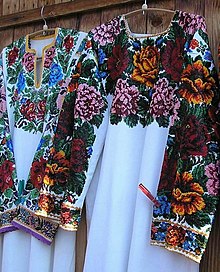This is an old revision of this page, as edited by 85.100.157.218 (talk) at 16:10, 5 January 2008. The present address (URL) is a permanent link to this revision, which may differ significantly from the current revision.
Revision as of 16:10, 5 January 2008 by 85.100.157.218 (talk)(diff) ← Previous revision | Latest revision (diff) | Newer revision → (diff) This article is about an ethnic group. For the horse breed, see Hucul pony.
Hutsuls (Template:Lang-uk, Romanian: Huţuli, singular Huţul, Hutsul dialect: Hutsule, singular Hutsul; alternatively spelled Huculs, Huzuls, Hutzuls, Gutsuls, Guculs, Guzuls, or Gutzuls; Polish: Hucuł, singular Huculi, Hucułowie) are an ethno-cultural group of highlanders who for centuries have inhabited the Carpathian mountains, mainly in Ukraine, but also in the northern extremity of Romania (in the areas of Bukovina and Maramureş), as well as in Slovakia and Poland.
Etymology
There are different versions for the origins of the name Hutsul. An explanation is that it comes from the Romanian word for "outlaw" (cf. Rom. hoţ - "thief", hoţul - "the thief"). Other explanations place their origins in the Slavic kochul - "wanderer","migrant", in reference to their semi-nomadic lifestyle, to the name of the Turkic tribe of the Uzy, and even to the name of the Moravian Serbian king Hetsyl.
History and origins
Hutsuls inhabit areas situated between the south-east of those inhabited by the Boykos, down to the northern part of the Romanian segment of the Carpathians.
There are several hypotheses concerning the origin of Hutsuls. According to one of them, Hutsuls are descendants of Slavic tribe Ulichs, that had to leave their previous homes near the Buh river under the pressure of Pechenegs .
Hutsuls identify themselves as a part of Ukrainian ethnos, having at the same time their local identity as a sub-ethnos .
Language
The Hutsul language is relatively unique. It is thought to be a dialect of Ukrainian with some Polish influences , , , , ). Several words in their dialect have Romanian origins (e.g. kyptar - "vest", from Rom. cheptar cf. Latin pectus; zgardy - "necklace", from Rom. zgardă, cf. Albanian shkardhë; bryndza - "cheese", cf. Rom. brânză).
Due to the current educational system, the Hutsul dialect is in danger of extinction. Compulsory education is done only in standardized literary Ukrainian. In recent times there has been a roots movement to keep the traditional Hutsul language alive.
Way of life and culture

These two garments are much more typical of Bukovinian style rather than Hutsul. Hutsul embroidery is much more geometrical in style, focusing on reds, oranges, yellows, and greens.
Traditional Hutsul culture is often represented by the colorful and intricate craftsmanship of their clothing, sculpture, architecture, woodworking, metalworking (especially in brass), rug weaving, pottery, and egg decorating (see pysanka). Along with other Hutsul traditions, as well as their songs and dances, this culture is often celebrated and highlighted by the different countries that Hutsuls inhabit. Hutsul culture bears a noted resemblance to the traditional culture of Romania , with that of western Ukraine , and with that of other mountainous people which may have similar origins, such as the Gorals in Poland and Slovakia and the Moravian Wallachians in the Czech Republic. Most Hutsuls belong to the Ukrainian Greek Catholic Church and the Ruthenian Catholic Church.
Hutsul society was traditionally based on forestry and logging, as well as cattle and sheep breeding; the Hutsuls are credited with having created the breed of horse known as the Hucul pony. They use unique musical instruments, including the "trembita" (trâmbiţa), a type of alpenhorn of Dacian origin, as well multiple varieties of the fife, or sopilka, that are used to create unique folk melodies and rhythms. Also frequently used are the bagpipe (duda), the jew's harp (drymba), and the hammered dulcimer - tsymbaly.
The Hutsuls served as an inspiration for many writers, such as Ivan Franko, Lesya Ukrainka, Mykhailo Kotsiubyns'kyi, Vasyl Stefanik, Marko Cheremshyna and Mihail Sadoveanu. Sergei Parajanov's film Shadows of Forgotten Ancestors (Тіні забутих предків), which is based on the book by Mykhailo Kotsiubyns'ky, portrays scenes of traditional Hutsul life.
Every summer, the village of Sheshory in Ukraine hosts a three-day international festival of folk music and art. Two Hutsul-related museums are located in Kolomyia, Ukraine: the Pysanky museum and the Museum of Hutsul and Pokuttya Folk Art. Traditional Hutsul sounds and moves were effectively used by the Ukrainian winner of the 2004 Eurovision song contest, Ruslana Lyzhychko.
See also
- List of Hutsul people
- Gorals
- Vlachs
- Moravian Wallachia
- Arkan
- Arcan dance
- Hutsulka
- Kolomyjka
- Holubka
- Ukrainian dance
External links
- Romanian-Hutsul and Hutsul-English glossaries
- Huţuls of northern Moldavia
- Huculs
- Famous Hutzul leader Oleksa Dovbush
- Introduction to Hutsul Country
- Hutsul Region of Ukraine
- Hutsul Portal (mostly in Romanian)
- The website of Poienile de sub Munte, a Hutsul village in Maramureş, Romania
- Photo exposition about Hutsul people in Ukraine